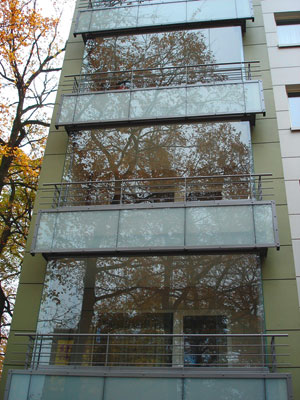Nature and Nurture: The Sustainable Benefits of All-Glass Operable Double-Wall Systems
 |
To revitalize this building facade and capture more year round usable space, an all-glass operable wall system was installed behind the guardrail. Photo courtesy of NanaWall Systems Inc. |
Herich was inspired by the early modernist work of architect Jan Duiker in the initial design stages for this administration building. Duiker's 1927 design for the First Open Air School for the Healthy Child was a forerunner for 21st century studies on the beneficial effects of daylight on learning. Duiker's building and subsequent all-glass buildings promised that access to nature led to increased vitality, energy and health of building occupants. Biophilia is the distinctive bond that philosophers like E.O. Wilson and Erich Fromm believe humans have to nature. This concept has influenced architects from the organic architecture of Frank Lloyd Wright to the biometrics of Dennis Dollens. The relationship between human comfort and the design of natural ventilation, orientation to views and daylight harvesting are components of most sustainable design metrics. The dilemma faced by most architects who are enamored of transparent buildings is that these glass structures may fail the high performance values necessary to reduce energy consumption.
According to studies by the Environmental Protection Agency (EPA), the building sector is responsible for 49 percent of all energy consumption and 47 percent of greenhouse gas emissions. Designers and engineers of buildings are both the source and the solution to the problems associated with climate change and the economics of scarce natural resources. The EPA estimates that between 2010 and 2030, building sector energy consumption will increase by 7.16 quadrillion Btus (QBtu). The EPA estimates that one QBtu is equal to the delivered energy of thirty-seven 1000-MW nuclear power plants or 235 coal-fired power plants at 200-MW each.1 The American Institute of Architects (AIA), the Mayor's Institute for Climate Change and Architecture 2030 are leading the call for the reduction of fossil fuels in buildings in the next twenty years. According to the 2030 Blueprint, a report written in 2008 by architect and founder of Architecture 2030, Ed Mazria, AIA, and co-author Kristina Kershner, design professionals need to reduce their use of fossil fuels by half. One strategy is to design more energy-efficient buildings.
The 2030 Challenge |
In January of 2006, Architecture 2030 officially issued the "2030 Challenge," as an achievable strategy to dramatically reduce global greenhouse gas emissions and fossil-fuel consumption in the building sector by the year 2030. Specifically, the Challenge calls for:
Architecture 2030 recommends that the fossil fuel reduction targets be achieved through design, the application of renewable energy technologies and/or the purchase of renewable energy (20 percent maximum).2 |
Â
Many high-performance building strat-egies encourage and sometimes require the reduction of the amount of glass in a building envelope. For example, the new American Society of Heating and Air-Conditioning Engineers (ASHRAE) 189.1, Standard for the Design of High-Performance, Green Buildings Except Low-Rise Residential Buildings, has been developed with the assistance of the U.S. Green Building Council (USGBC), the Illuminating Engineering Society (IES) and the American Institute of Architects as a basis for municipal codes in the United States. Prescriptive requirements are listed as well as guidelines and requirements for the building envelope that limit the amount of fenestration depending on climate and integrated design strategies.









